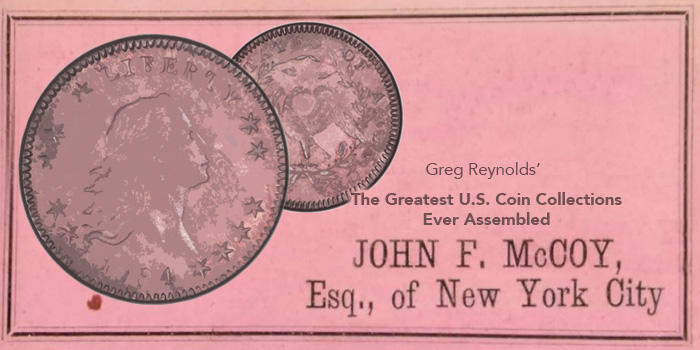Coin Rarities & Related Topics: News and Analysis regarding scarce coins, markets, and coin collecting #390
A Weekly Column by Greg Reynolds …..
This series is about comprehensive collections of classic U.S coins (1793-1934) that were offered, at least in large part, at public auctions. The first comprehensive collection of U.S. coins to be auctioned this way was that of John F. McCoy from May 17 through 21, 1864 at 498 Broadway in New York, “commencing each day at precisely five o’clock.” This collection had an impact in terms of stimulating interest in collecting rare U.S. coins and making public information about rarities that was previously available only to collectors. Surely, not many people then were aware of all the Proof coins dating from the 1820s, ’30s and ’40s that could be collected.
In addition to commenting upon McCoy and his collection, background information regarding collecting, grading and market values during the 1860s is put forth here. A PDF version of the McCoy catalog is available via the Newman Numismatic Portal. In May 2016, the firm of Kolbe & Fanning sold a “Near Fine” original catalog, which was bound in cloth well after 1864, for $199.75.
Collections Sold Before 1864
This was not, however, the first collection of coins to be auctioned in the U.S. that contained a significant grouping of U.S. coins and patterns. The first in that regard was perhaps the collection of the late Dr. Lewis Roper, which was auctioned on February 20, 1851. Roper, though, had just a small number of U.S. patterns and even fewer noteworthy rare U.S. coins. Dr. Roper had more U.S. patterns and pre-1793 American items than U.S. coins, which did not seem to be a major part of his collection.
The Kline Collection was auctioned in Philadelphia during June 1855 and is pertinent. Among other numismatic pursuits, Kline ardently collected copper, silver and gold U.S. coins of all denominations below 10 dollars. Kline systematically assembled a collection by year of U.S. coins dating from 1793 to 1854. Although he was missing more than a few rarities, Kline’s collection was fairly comprehensive. In the area of U.S. coins, it was vastly superior to any collection of U.S. coins that had been auctioned before 1855.
The U.S. coin component of John McCoy’s collection was amazingly complete for one that was finished in early 1864! There was at the time minimal published information about rare U.S. coins. “This was the first great sale of American coins, excellent and thorough in all areas, including colonials, patterns and gold,” exclaims numismatic author and researcher Saul Teichman.
 As far as I know, there is no evidence that McCoy bought a large part of his coin collection from someone else.
As far as I know, there is no evidence that McCoy bought a large part of his coin collection from someone else.
Furthermore, as he clearly enjoyed collecting, it is unlikely that McCoy just bought another large collection and called it his own. Nevertheless, if he did, then someone else was responsible for a remarkable achievement. In the realm of U.S. coins, it was far greater in scope, quality and sophistication than any collection that had been publicly detailed before the McCoy Collection was auctioned in 1864.
There is some evidence to suggest that Robert Gilmor, Jr. (1774-1848) had assembled a fabulous collection of American colonial and U.S. coins that was distributed privately after 1841. It is certain that he owned a Brasher Doubloon. Joel Orosz has revealed evidence that Gilmor was well acquainted with senior officials at the Philadelphia Mint, and was granted special favors by them.
Orosz wrote an article that was published in the May 1990 issue of The Numismatist, which provides much information regarding Gilmor and his interest in coins. Orosz found that Gilmor had assembled a “nearly complete collection” of copper, silver and gold coins issued by the Philadelphia Mint until around 1840.
By 1864, Joseph Mickley and Matthew Stickney had been seriously collecting U.S. coins for decades. The details of their respective collections, however, were not widely known at the time that McCoy’s collection was auctioned. Mickley’s copper and silver coins were purchased and cataloged by W. Eliot Woodward before being auctioned in 1867.
Woodward had purchased McCoy’s collection intact and then cataloged it for auction. Before the 1880s, it was common for a coin firm to purchase a collection and then auction it rather than accept consignments. As was typical in the middle of the 19th century, Woodward contracted with a firm to help organize the planned auction and provide a suitable environment for the event.
McCoy as Collector
Circumstantial evidence hints that McCoy, a lawyer in New York, was also a widely recognized collector of historical documents and rare books. In 1902, Felix Neumann of the Library of Congress noted that “in the middle of November, 1900, there was sold at auction in London by Sotheby, Wilkinson & Hodge, a part of the library of Lord Ashburton that was especially rich in scarce and unique books, and the sale attracted, therefore, consider able interest among book-collectors. The highest bid reached — £400, or $2000 — during the sale, which lasted four days, was for a tract of only 21 pages text, [listed there as] Daniel Denton’s Brief Description of New York, formerly called New Netherlands, London, 1670.”
Before 1902, Felix Neumann was able to trace just 24 originals of this publication in 1670 by Denton about New York. Neumann acknowledged that his list of 24 may not amount to 24 different items. One of the 24 surviving copies belonged to John F. McCoy during the 1860s and perhaps earlier. So, McCoy owned one of the most valuable historical publications in English regarding North America.
In the 19th century, the standard reference for books and pamphlets relating to North America, the U.S. in particular, was authored by Joseph Sabin and is comprised of thousands upon thousands of pages in more than 15 volumes. The second volume, which was published in 1869, was dedicated to John McCoy, and other volumes may have been as well. Rare items owned by McCoy are cited by Sabin.
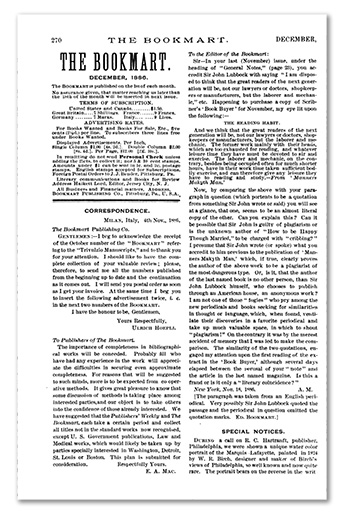 In the November 1886 issue of The Bookmart (Pittsburgh), there is a discussion of an extensive collection of rare books and historical documents that was formed by John Rice and auctioned in New York at the Bangs firm in 1870. “Mr. Rice’s collection of Americana [began with] the purchase [of] Mr. John F. McCoy’s library in this department,” it was reported (on p. 224).
In the November 1886 issue of The Bookmart (Pittsburgh), there is a discussion of an extensive collection of rare books and historical documents that was formed by John Rice and auctioned in New York at the Bangs firm in 1870. “Mr. Rice’s collection of Americana [began with] the purchase [of] Mr. John F. McCoy’s library in this department,” it was reported (on p. 224).
McCoy was very active with the American Numismatic Society (ANS) in New York, even a dozen years after his coin collection was sold. The first issue of the American Journal of Numismatics (AJN) in 1866 notes that McCoy was elected second vice president of the the society, evidently the third-highest-ranking post at the time. He also served on committees. At the “regular meeting” on October 28, 1866, McCoy donated “two large and elaborate medals in bronze of Gen. Scott, by C. C. Wright” (AJN, Vol 1: No. 7, p. 50).
The McCoy Collection
Silver Dollars
Medals and colonials are topics for another day; the theme here involves U.S. coins. The first extensive run of U.S. coins in the McCoy auction event was of silver dollars. The McCoy 1794 dollar is non-gradable, though a 1795 Flowing Hair silver dollar was evidently very prooflike. A second 1795 Flowing Hair dollar was said to be of a different variety.
Two 1795 Draped Bust dollars are cataloged as different varieties. Woodward’s remarks suggest that both could be very high-quality coins. McCoy had both a 1796 ‘Small Date’ and a 1796 ‘Large Date’, as well as both major varieties of 1797 dollars.
The two 1798 ‘Small Eagle’ silver dollars went to leading collectors of the time. The “uncirculated” 13 star piece went to Joseph Levick and the 15 star coin to H. Ely, who was then forming an unquestionably great collection. A third legendary collector, Col. Mendes I. Cohen, acquired the McCoy “uncirculated” 1798 Heraldic Eagle silver dollar.
Cohen also bought the next lot, a “Splendid impression, uncirculated” 1799. McCoy had two additional 1799 dollars, for a total of three, all of different varieties. Further, he had an 1800, an 1801, an 1802/1, and two varieties of 1803 dollars. McCoy had a replica of an 1804 dollar rather than a genuine coin.
It is interesting that an 1836 Gobrecht dollar realized $10.50, a price that was substantially higher than any one of the early 19th-century dollars that were just mentioned. A second 1836 Gobrecht dollar was included in a six-piece 1836 Proof set, five silver pieces and a half cent. The $42.50 price for the set was a large sum then, but a single 1838 Gobrecht dollar garnered $33 and an 1839 went for $40! Either bidders at the auction valued Gobrecht dollars higher than Draped Bust dollars or the quality of these particular Gobrecht dollars was responsible for large portions of the prices realized.
Seven different bidders, including leading collectors of the era, purchased Liberty Seated dollars from the 1840s, most of which were probably Proofs. Proof sets dating from 1847 to 1850, each with five pieces, were sold along with the silver dollars. Six-piece Proof sets from 1854 and 1855 were included, too, as were seven-piece Proof sets dating from 1856 to 1858, each with a Flying Eagle cent.
Although most collectors during the era ignored mintmarks and/or ignored the products of the U.S. Branch Mints, Woodward had 1850-O, 1859-O and 1859-S silver dollars. His “uncirculated” 1859-O might then have been a curious condition rarity.
McCoy could well have had more business strikes from 1810 to the 1864 that were considered too trivial to include in the collection that was sold to Woodward or considered by Woodward to not be worth enough to include in this auction. Saul Teichman notes that, in the 19th century, “[M]any scarce U.S. coins that would grade below AU today were worth face value or bullion value.” Teichman adds that this was true of the Parmelee sale and of other important coin auctions in the 19th century. Therefore, many McCoy Collection coins, including low-grade representatives of rarities, may have been excluded from the auction for business reasons.
Half Dollars
Given the norms and difficulties involved in acquiring coins at the time, the completeness of McCoy’s collection is astonishing. H. Ely, Colonel Cohen and James Ten Eyck battled for most of McCoy’s half dollars dating from 1794 to 1828. Others captured a few, including Zanoni and Levick, who are each legends among copper collectors in the present.
McCoy had at least one half dollar, usually more than one, of every single year from 1794 to 1864. Like most collectors before the 1980s, McCoy considered Proofs to be superior to business strikes, not just products of a different method of manufacture. He did not feel a need to have a business strike of a date that was represented by a Proof, though he often did have both a Proof and a business strike of the same date and type.
McCoy’s 1794 half dollar probably was not a highlight, though it did sell for $5.50 to Ely. His 1795 half, which is not nearly as scarce as a 1794 half, brought $10, yet a 1795 half that is PCGS-graded EF-40 now would then have been worth maybe $1.35. McCoy’s 1796 Sixteen Stars half brought $27.50, while his 1796 Fifteen Stars half realized just a little less, $27 even.
Very prooflike 1797 halves are not presently known, and I have seen all those that now grade 63 to 66. I am curious as to which 1797 McCoy owned, perhaps one that has been mistreated over the years. It was then said to be a “Splendid Proof, the finest known”! James Ten Eyck bought it for $83.50, an incredible amount at the time.
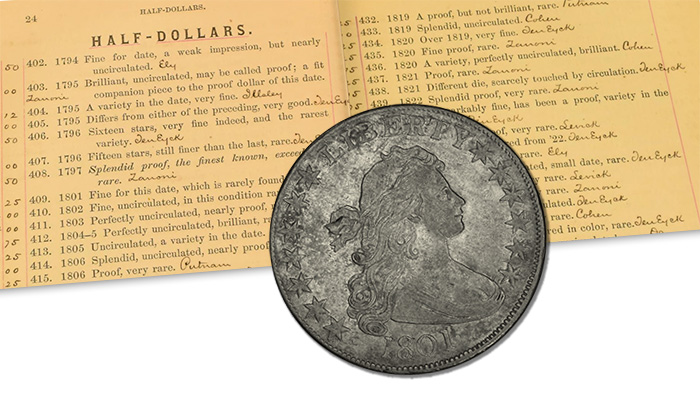
Note that the 1801 and the 1802 are of commensurate rarity, both the best dates of the Heraldic Eagle design type. A circulated 1801 half dollar then brought $1.25 while an “uncirculated” 1802 commanded $4. A “perfectly uncirculated 1803”, however, is not nearly as rare as an 1802, one of which also brought $4 at the McCoy auction. It may have been a gem quality coin, MS-65 or higher in terms of present criteria and standards.
A “perfectly uncirculated” 1805/4 brought almost as much $3.75. There is circumstantial evidence in the catalog and prices realized that a gem quality type coin could then have been worth more than a non-choice “uncirculated” representative of a key date in some series. The catalog descriptions and prices realized suggest that many of the half dollars would grade from 64 to 67 by present standards, as most Capped Bust halves then were worth around their bullion value.
“It is important to note that the descriptions in the McCoy catalog do not translate to today’s grades,” remarks Saul Teichman. “A coin described as very fine would grade AU or better today.”
A coin that is graded as “uncirculated” and as “Very Fine” might well grade 65 or higher in the present. “Uncirculated” or “Proof” coins that were termed “splendid” by Woodward might, too, have qualified then for 65 to 67 grades now. There is no way to be certain of the quality of any specific coin in the McCoy Collection. Grading and related terms were used loosely in the 19th century. Graders active in all eras are imperfect and coins change over time.
Also, the fact that McCoy had two varieties of 1807 Draped Bust halves and an 1807 Capped Bust half, along with many major varieties of bust dollars, constitutes additional evidence that he was not just collecting coins ‘by year’. McCoy had quite a few additional varieties, respectively, of coins of the same denomination, type and year. In addition to including major varieties of many coins, there were many instances where McCoy had both business strike and Proof representatives of the same denomination, type and date.
A puzzling number of McCoy’s bust half dimes, dimes, quarters and half dollars were cataloged as Proofs. It is generally believed that more than 50%, though nowhere near 100%, of the post-1817 coins that Woodward cataloged as being Proofs would be regarded as Proofs in the present. Given the reality that McCoy almost certainly had a run of Proof sets from 1840 to 1864, and also had pre-1840 sets or partial sets, it would be unsurprising if he had a substantial number of true Proof coins from the 1820s and ’30s.
Additionally, there were quite a few coins that Woodward cataloged as “almost proof”! As Woodward tended to refer to other coins as “was Proof” or as having been impaired, some of the “almost Proof” coins are probably very distinctive coins that come close to qualifying as Proofs but ultimately fall short.
McCoy had two Philadelphia Mint 1840 half dollars: one was a “Proof” that “has been slightly circulated”, and the other was described as “Splendid impression, perfectly uncirculated.” McCoy also had an 1840-O half.
McCoy had an important group of New Orleans Mint Liberty Seated halves: 1845-O, 1848-O, 1849-O, 1852-O, 1854-O, 1856-O, and 1861-O. In some ways, McCoy’s New Orleans Mint collection was path breaking and way ahead of his time. It was then almost unthinkable for a collector to seek a set of high-grade New Orleans Mint half dollars.
There was no 1838-O half, but McCoy had an “uncirculated” 1839-O presumably with exceptional surfaces. The McCoy 1839-O was purchased by James Ten Eyck. In 1922, B. Max Mehl sold Ten Eyck’s collection, which was phenomenal.
Quarters
Many of the coins in the McCoy Collection realized prices way beyond the levels then that would be associated with coins that now would be graded from EF-45 to MS-63. McCoy was said by Woodward to have “one of the finest known” 1796 quarters, yet his 1804 quarter brought more in this auction, $22.50 versus $21 for the 1796. The 1804 thus brought almost as much as each of the already mentioned 1796 half dollars, which were widely recognized rarities in 1864.
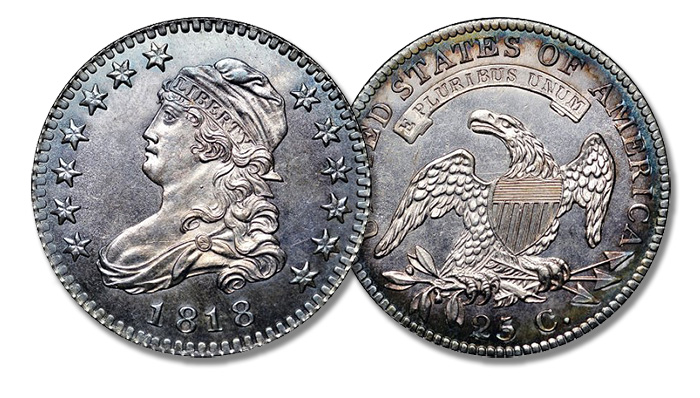
As Eric Newman had an 1818 quarter that has been traced to the Cleneay sale in 1890, I would not be surprised if the “Proof” 1818 in the McCoy sale is this same coin. I extensively analyzed the Newman 1818 here.
Of course, McCoy had “1823” and “1827” quarters. Indeed, McCoy had the 1827/3/2 quarter, which was purchased by H. Ely at the auction and was later in the Garrett, Knoxville and Pogue Collections. This is generally regarded as the finest known 1827/3/2 quarter, all of which are overdates.
Among copper and silver series, McCoy had almost all the Philadelphia Mint rarities. James Ten Eyck purchased McCoy’s 1840-O and 1841-O quarters. McCoy had an 1842-O, too.
Dimes and Half Dimes
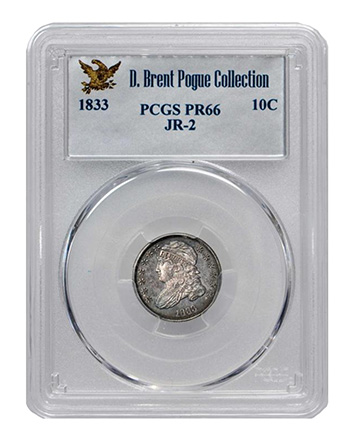 There were many coins in the auction that were cataloged as “perfectly uncirculated”, though far fewer in most other auctions cataloged by Woodward. McCoy’s 1809 and 1811 dimes may have been very appealing. The idea that the Cleneay-Earle-Pogue Proof 1833 dime was earlier in the McCoy Collection is not merely speculation. Such a theory is extremely plausible.
There were many coins in the auction that were cataloged as “perfectly uncirculated”, though far fewer in most other auctions cataloged by Woodward. McCoy’s 1809 and 1811 dimes may have been very appealing. The idea that the Cleneay-Earle-Pogue Proof 1833 dime was earlier in the McCoy Collection is not merely speculation. Such a theory is extremely plausible.
“The mid-1860s were perhaps Cleneay’s busiest time for acquisitions,” notes John Krajelvich in the Pogue III catalog. “Lot 574 in the McCoy sale was described as ‘1833 Brilliant proof, extremely rare.’ It sold for $3.75, more than similarly described Proof dimes of 1823, 1827, 1829, 1830, 1831, 1832, and 1834,” JK adds.
Scott Travers and I are in agreement that this coin is unquestionably a Proof, though we both were not completely in agreement with the assigned “66” grade. I noted that this dime did not pass at CAC. Nevertheless, it is a gem quality coin–perhaps deserving of a “65+”–and scores very high in the category of originality. The Cleneay-Earle pedigree is exceptionally important and such pedigrees will be discussed later in this series on the the greatest collections to have been auctioned.
Of course, a comprehensive collection of all series of classic U.S. coins must contain some coins that are far from being gems. It was honest of Woodward to emphasize all the imperfections that characterize the McCoy 1802 half dime, “very badly worn” with some “wholly obliterated” design elements and featuring “scratches across the face”!
Cents & Half Cents
More so than coins of other denominations, large cents known in the present have been traced to the McCoy Collection. A few of these have been covered in my past discussions, including the McCoy-Parmelee-Mills-Garrett-Naftzger-Cardinal-Pogue 1794 ‘Head of 1793’ cent. Also, there is a Proof 1830 large cent that has been pedigreed to the McCoy, Zanoni, Cleneay, Mougey, Newcomb, Starr and Naftzger Collections.
McCoy may have had some really amazing type coins in his set of half cents, along with an “uncirculated” 1796. Woodward raved about 1793, 1794 and 1796 half cents in this sale. It is extremely difficult, however, to interpret listings of McCoy Collection half cents in the present.
Gold Coins
A combination of the catalog descriptions, the prices realized in the context of coin markets in 1864, and the historical reputation of the McCoy Collection suggests that at least some of McCoy’s bust eagles ($10 gold coins) would grade from 65 to 67 if it is imagined that the coins then could be fairly graded now.
Although both 1797 eagles were said by Woodward to be “splendid”, the 1797 ‘Small Eagle’ reverse brought much more than the 1797 Heraldic Eagle: $51 versus $31. Although Cohen captured the 1797 ‘Small Eagle’ ten, Ely bought five of McCoy’s bust eagles, and Zanoni purchased two.
Although some of them may very well have been of superb quality, the half eagles were the least impressive portion of the McCoy Collection. The McCoy quarter eagles were more much impressive than his half eagles, in terms of completeness. It is very plausible that McCoy owned one of the all-time greatest sets of Capped Head quarter eagles.
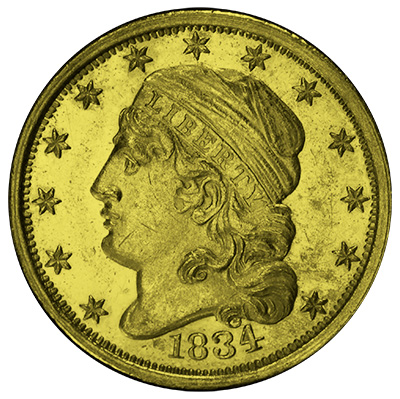 A “Proof” 1826 realized $21, more than twice as much as any of the other Capped Head quarter eagles that were cataloged as Proofs in this sale. An 1834 Capped Head, a famous rarity, brought $20, two to three times the value of an exceptional representative of a common date, business strike or Proof.
A “Proof” 1826 realized $21, more than twice as much as any of the other Capped Head quarter eagles that were cataloged as Proofs in this sale. An 1834 Capped Head, a famous rarity, brought $20, two to three times the value of an exceptional representative of a common date, business strike or Proof.
McCoy had gold Proof sets of several dates and a set of One Dollar Gold pieces from 1849 to 1863. It is noteworthy that the 1849 and those dating from 1854 to 1862 were cataloged as Proofs while the One Dollar Gold pieces dating from 1850 to 1853 were cataloged as business strikes. I have seen at least one 1849 that I regard as a true Proof, though no One Dollar Gold pieces from 1850 to 1853 that qualify as Proofs. Of course, there exist 1854 and 1855 Proofs of the relatively rare second type.
Concluding Thoughts
It is not practical to review a large part of the McCoy Collection here. One purpose was to convey the extent to which the McCoy Collection was complete and to theorize as to the overall quality of the collection. Excluding half eagles, among Philadelphia Mint U.S. coins dating from 1793 to 1864, very few were missing from the McCoy Collection!
If he had collected for another three to five years, McCoy may very well have come within two or five coins of a complete set of Philadelphia Mint U.S. coins, including major varieties regarded as distinct dates at the time. It is sad that coin enthusiasts now cannot see how his coins then appeared.
© 2017 Greg Reynolds


